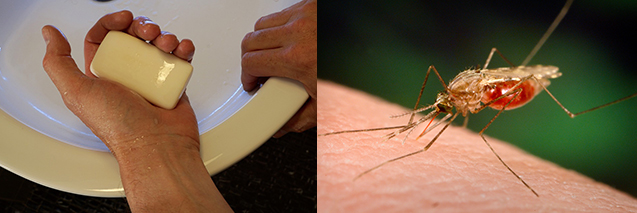Cheap, stable, and easily produced compounds have been the basis of antimalarial drug development for more than half a century. However, with drug resistance continuing to rise, identifying targets that impede essential metabolic pathways at multiple times during the parasite’s life cycle is a vital approach to drug design. Now, a new study led by investigators at the University of Campinas (UNICAMP) in Brazil shows that triclosan, an antimicrobial compound used in soap, toothpaste, deodorant, and many other products, can inhibit target genes in the malaria parasite during two crucial stages of its life cycle in humans—the hepatic stage, when it reproduces in the host's liver cells, and the erythrocytic stage, when it infects red blood cells.
Findings from the new study were published recently in Scientific Reports, in an article entitled “Plasmodium Dihydrofolate Reductase Is a Second Enzyme Target for the Antimalarial Action of Triclosan.” In the article, the authors note that triclosan has been used for 40 years and is considered safe by health authorities. The fact that the substance combats even parasites resistant to the drugs currently used to treat malaria, as the study showed, makes it “an exciting candidate for further development as a dual specificity antimalarial, which could target both the liver and blood stages of the parasite.”
“The compound itself could be a therapeutic option, but I believe it would be more worthwhile to develop analogous molecules with minor structural alterations that could make it even more effective against the parasite,” explained lead study investigator Elizabeth Bilsland, Ph.D., a professor in the structural and functional biology department of UNICAMP's Biology Institute.
Caused by protozoan parasites of the genus Plasmodium, malaria kills over half a million people per year worldwide, the vast majority in Africa. Approximately 90% of fatal cases are attributed to infection by P. falciparum. In Brazil, 85% of all malaria cases are caused by P. vivax, which induces milder symptoms but can remain dormant in the liver for years, triggering fresh bouts of malaria and hindering eradication of the disease by lengthening the time during which the infected host remains contagious.
8-Aminoquinoline compounds, such as tafenoquine and primaquine, are the main drugs currently used to treat the hepatic stage of P. vivax malaria, in association with other medications that attack the parasite in the erythrocytic stage. Yet, approximately 10% of those infected have a mutation in the gene that encodes the enzyme G6PD, or glucose-6-phosphate dehydrogenase, and suffers severe side effects during treatment with tafenoquine or primaquine. In the worst cases, hemolysis (destruction of red blood cells) may occur, and this can be fatal.
“The development of new drugs that can attack P. vivax in both the hepatic and erythrocytic stages is urgently needed since there are reports of parasites resistant to each of the antimalarial drugs on the market,” Dr. Bilsland comments. “If there are different targets, they'll be less likely to develop drug resistance.”
As far back as 2001, research studies showed that triclosan could inhibit parasite development through an enzyme called type II fatty acid synthase (FAS-II). Moreover, triclosan was also shown to have cured mice with malaria. However, subsequent studies showed that this enzyme is not essential to the parasite's growth in culture. As Dr. Bilsland noted, the tests had been performed with parasites in the erythrocytic stage.
“Actually, FAS-II is only important to the parasite's survival in the hepatic stage,” Dr. Bilsland added. “Now, we've shown through experiments using yeast that triclosan also inhibits the enzyme dihydrofolate reductase (DHFR), an essential target for the erythrocytic stage of the parasite.”
The discovery of triclosan's second mechanism of action by the research team happened almost by chance while they were conducting a large-scale screening of compounds approved for human use by the FDA, in search of drugs that could inhibit the enzyme DHFR in Plasmodium.
“We've developed a method whereby we replace yeast genes with human genes or with target genes in parasites that cause diseases like malaria, Chagas, and schistosomiasis,” Dr. Bilsland remarked. “We label our strains with different-colored fluorescent proteins, so we know red is yeast with a human gene, for example, while blue stands for a Plasmodium gene, green for a Trypanosoma gene, and yellow for a Schistosoma gene.”
The method enables the researchers to grow different strains of modified yeast in single wells of microtiter trays with hundreds of wells and treat them simultaneously with thousands of drugs, she added, thanks to a “robot scientist” called Eve developed at the University of Manchester.
“We observed cases in which the yeast with a Plasmodium gene died, and the one with a human gene survived, and in this way, we screened compounds with specific antiparasitic action,” Dr. Bilsand stated. “Triclosan gave the best results, with both normal and drug-resistant DHFR.”
Several biochemical assays, computer simulations, and experiments with yeast were performed to validate triclosan's action against DHFR. The results showed that the substance was effective even against parasites resistant to pyrimethamine, a recognized DHFR inhibitor used in malaria prevention and treatment.
“We also showed that triclosan has 20 times greater affinity for the parasite's enzyme than for the human equivalent, a key feature in a candidate drug,” Dr. Bilsland concluded.






